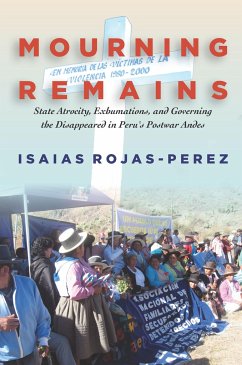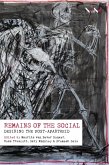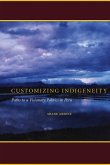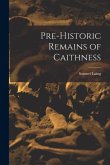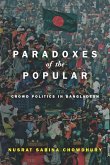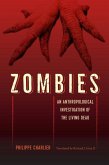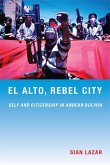Isaias Rojas-Perez
Mourning Remains
State Atrocity, Exhumations, and Governing the Disappeared in Peru's Postwar Andes
Isaias Rojas-Perez
Mourning Remains
State Atrocity, Exhumations, and Governing the Disappeared in Peru's Postwar Andes
- Broschiertes Buch
- Merkliste
- Auf die Merkliste
- Bewerten Bewerten
- Teilen
- Produkt teilen
- Produkterinnerung
- Produkterinnerung
Mourning Remains examines the attempts to find, recover, and identify the bodies of Peruvians who were disappeared during the 1980s and 1990s counterinsurgency campaign in Peru's central southern Andes. Isaias Rojas-Perez explores the lives and political engagement of elderly Quechua mothers as they attempt to mourn and seek recognition for their kin. Of the estimated 16,000 Peruvians disappeared during the conflict, only the bodies of 3,202 victims have been located, and only 1,833 identified. The rest remain unknown or unfound, scattered across the country and often shattered beyond…mehr
Andere Kunden interessierten sich auch für
![Remains of the Social Remains of the Social]() Remains of the Social42,99 €
Remains of the Social42,99 €![Customizing Indigeneity Customizing Indigeneity]() Shane GreeneCustomizing Indigeneity30,99 €
Shane GreeneCustomizing Indigeneity30,99 €![Death and the Idea of Mexico Death and the Idea of Mexico]() Claudio LomnitzDeath and the Idea of Mexico26,99 €
Claudio LomnitzDeath and the Idea of Mexico26,99 €![Pre-Historic Remains of Caithness Pre-Historic Remains of Caithness]() Samuel LaingPre-Historic Remains of Caithness22,99 €
Samuel LaingPre-Historic Remains of Caithness22,99 €![Paradoxes of the Popular Paradoxes of the Popular]() Nusrat Sabina ChowdhuryParadoxes of the Popular32,99 €
Nusrat Sabina ChowdhuryParadoxes of the Popular32,99 €![Zombies Zombies]() Philippe CharlierZombies17,99 €
Philippe CharlierZombies17,99 €![El Alto, Rebel City El Alto, Rebel City]() Sian LazarEl Alto, Rebel City42,99 €
Sian LazarEl Alto, Rebel City42,99 €-
-
-
Mourning Remains examines the attempts to find, recover, and identify the bodies of Peruvians who were disappeared during the 1980s and 1990s counterinsurgency campaign in Peru's central southern Andes. Isaias Rojas-Perez explores the lives and political engagement of elderly Quechua mothers as they attempt to mourn and seek recognition for their kin. Of the estimated 16,000 Peruvians disappeared during the conflict, only the bodies of 3,202 victims have been located, and only 1,833 identified. The rest remain unknown or unfound, scattered across the country and often shattered beyond recognition. Rojas-Perez examines how, in the face of the state's failure to account for their missing dead, the mothers rearrange senses of community, belonging, authority, and the human to bring the disappeared back into being through everyday practices of mourning and memorialization. Mourning Remains reveals how collective mourning becomes a political escape from the state's project of governing past death and how the dead can help secure the future of the body politic.
Hinweis: Dieser Artikel kann nur an eine deutsche Lieferadresse ausgeliefert werden.
Hinweis: Dieser Artikel kann nur an eine deutsche Lieferadresse ausgeliefert werden.
Produktdetails
- Produktdetails
- Verlag: Stanford University Press
- Seitenzahl: 344
- Erscheinungstermin: 1. August 2017
- Englisch
- Abmessung: 231mm x 151mm x 25mm
- Gewicht: 469g
- ISBN-13: 9781503602625
- ISBN-10: 1503602621
- Artikelnr.: 47281004
- Herstellerkennzeichnung
- Libri GmbH
- Europaallee 1
- 36244 Bad Hersfeld
- gpsr@libri.de
- Verlag: Stanford University Press
- Seitenzahl: 344
- Erscheinungstermin: 1. August 2017
- Englisch
- Abmessung: 231mm x 151mm x 25mm
- Gewicht: 469g
- ISBN-13: 9781503602625
- ISBN-10: 1503602621
- Artikelnr.: 47281004
- Herstellerkennzeichnung
- Libri GmbH
- Europaallee 1
- 36244 Bad Hersfeld
- gpsr@libri.de
Isaias Rojas-Perez is Associate Professor of Anthropology at Rutgers, The State University of New Jersey-Newark.
Contents and Abstracts
Introduction:
chapter abstract
This introduction offers an overview of the book's themes. It starts by
situating the discursive context in which the Peruvian post-conflict of
reckoning with past violence came into being. The chapter then introduces
the concept of necro-governmentality-a form of power that by means of
governing dead bodies seeks to structure the field of action and speech of
survivors and society at large to prevent the repetition of violence. The
book describes how this form of power emerges in response to Necropower, or
power's capacity to create "death worlds" (Mbembe). This framework is
central to understand the ways the survivors' response to atrocity stands
in its own right at the intersection of these two forms of power. This
framework shows that the unique contribution of the book is its focus on
how death is actually managed, experienced, negotiated and mourned in
post-conflict settings-a theme barely treated in the literature on
transitional justice.
1Death in Transition: Reclaiming the Unknown Dead in Post-conflict Peru
chapter abstract
This chapter offers a partial history of how the question of recovering the
remains of victims of the internal war for proper burial came to occupy
center stage in Peru's post-conflict project of nation making. It traces
how a legal project that started with the with the specific goal of
shedding light on the whereabouts of the disappeared by the state ended up
in a humanitarian project of exhumation and reburial of forgotten victims
of both the Shining Path and the army. It situates this shift within the
unfolding of a broad project of reckoning with past violence, including a
truth commission, exhumations and prosecutions, under of the human rights
notion of "right to truth." The chapter conceptualizes this development as
"necro-governmentality of post-conflict" and shows how it was initially
implemented and how Quechua-speaking survivors received, accommodated, and
contested this project to put forward their own projects of reckoning.
2Malamuerte: Governing Tragic Death in the Andes
chapter abstract
This chapter examines the question of why Quechua-speaking survivors and
relatives buried hastily the bodies of their slaughtered relatives in the
places where they had fallen and did not attempt to move those bodies to
consecrated ground. It focuses on a case of suicide in the rural community
of Accomarca to offer an ethnographic account of how Andean villagers cope
with tragic death (or "bad death") in ordinary contexts. It traces the
relations of specificity and continuity between state and cultural
practices to properly dispose of the dead body and address suffering in
cases of transgressive death. The chapter explores the gendered division of
labor in mourning and highlight the central role of women in ordinary
mortuary rituals. Finally, it shows how, by contrast, the 1985 massacre at
the hands of the state cannot be absorbed through these ordinary practices
until such killing is first legally, politically, and historically
prosecuted.
3Excavating State Atrocity
chapter abstract
This chapter explores the question of what kind of forensic object state
atrocity is. In doing so, it follows the work of forensic archaeologists
during the exhumation of clandestine mass graves at Los Cabitos-the former
regional headquarters of the counterinsurgency in Peru's central southern
Andes. It shows how archaeologists working as legal experts in contexts of
mass killing and atrocity are trapped in power relations, while their
practice is not independent of power and politics. It offers an
ethnographic account of how the forensic findings that proved practices of
state atrocity at Los Cabitos were first made possible by the unexpected
intrusion at the site of a drunken man who was not part of the legal
procedures. Following Latour, the chapter shows that through laymen who
have witnessed the past, or through its material remains, the past objects
to how it is produced and spoken of by the experts.
4The Cry: Memories of the Present
chapter abstract
This chapter begins an account of the ways the Quechua mothers of the
disappeared engage the forensic exhumation at Los Cabitos. In particular,
it focuses on the stories of suffering they retell at the former site of
mass killing to reflect on the nature of the disappearance as an ongoing
event. These stories speak of the disappearance in terms of both the
specific act of abduction of the body as well as the different languages,
performance of authority and practices of denial through which state
authorities sanctioned the disappearance in the past and continue to subtly
sanction it in the present. In this sense, the chapter shows the inadequacy
of trauma theories that typically tend to situate the event of violence in
the past. Instead, the chapter suggests that any rendering of this kind of
violence should look at the double political temporality of past/present in
which it unfolds as an ongoing event.
5Caprichakuspa: Witnessing Before Terror
chapter abstract
This chapter explores the gendered dimensions of the response to state
atrocity. In particular, it interrogates the age-old wisdom that women
engage politics in contexts of violence motivated only by their desire to
protect the sacred rights of their families as opposed to the rights of the
sovereign. This view confines women's agency to the realm of the
"pre-political" as opposed to the "political sphere." This chapter shows
how, by contrast, the mothers started their search out of their love for
their missing relatives, but in this search they end up engaging questions
concerning the possibility of political community itself in the face of
sate atrocity. It shows how the mothers relate to the sovereign's power to
kill in terms of escape and movement, and how this gesture of disobedience
as a form of political action evokes the figure of the people walking away
from the sovereign's binding and shepherding powers.
6Talking Soul: Reclaiming Death as Human Experience
chapter abstract
This chapter offers an ethnographic account of the ways the mothers
reinvent death as human experience in response to practices of state
atrocity akin to what Arendt called "fabrication of corpses." Because the
forensic technologies are unable to produce the individual missing bodies,
the mothers mobilize ordinary practices of mourning to both imagine the
presence of those bodies at the site of mass killing and mourn them in the
subjunctive mood of the "might be." It is a gesture that envisions the
figure of the mother moving between two deaths-death as biological
termination of life and death as human experience-attempting to bring the
disappeared back into some form of social being. Central to this gesture
are the agency Andean people assign to dead bodies and how they see the
relationship between body, soul, and the Earth. The chapter conceptualizes
this imperfect form of mourning as "subjunctive mourning."
7The Magic of Justice: Or How to Ensoul the Work of Law
chapter abstract
This chapter looks at the assemblage of everyday practices of the self and
technologies of truth (dreams, apparitions, and rites of propitiation) that
the mothers bring to the site of mass killing, to animate the work of
justice in response to atrocity. Modern politics see these practices and
technologies as premodern relics and vestiges of "magical" practices. The
chapter examines the ways these "magical" practices enter into a
relationship of adjacency with the rational practices of the law and
forensic science, to together confront, in their own distinct terms, the
longstanding legacies of state terror. While the work of the former depend
for their efficacy on the work of the latter, the former go beyond the
rational limits of the latter to create conditions of possibility for truth
and justice in the face of forms of violence that have gone beyond the
thresholds within which Andean peoples test what a human form of life is.
8"The Glory of the Disappeared": Or the Figure of the People
chapter abstract
This chapter looks at the ceremony of inauguration of "La Cruz de la
Hoyada" at the former site of mass killing of Los Cabitos. It examines the
historical and political saliency of this symbol and the ways it embodies a
claim on political community in the aftermath of state atrocity. The
chapter shows how, in reclaiming the site as a space for justice and
mourning, the mothers at once level a radical critique of the sovereign
power to kill and respond to the inability of the law and forensic sciences
to reconstitute the weave of life torn by state terror. The chapter argues
that insofar as it stands in its own right at the intersection between the
trajectories of necropower and necro-governmentality, the makes a claim on
political community. It thus evokes the figure of the people emerging as a
necessary response to keep at bay the state's ever-present capacity for
"fabrication of corpses."
Introduction:
chapter abstract
This introduction offers an overview of the book's themes. It starts by
situating the discursive context in which the Peruvian post-conflict of
reckoning with past violence came into being. The chapter then introduces
the concept of necro-governmentality-a form of power that by means of
governing dead bodies seeks to structure the field of action and speech of
survivors and society at large to prevent the repetition of violence. The
book describes how this form of power emerges in response to Necropower, or
power's capacity to create "death worlds" (Mbembe). This framework is
central to understand the ways the survivors' response to atrocity stands
in its own right at the intersection of these two forms of power. This
framework shows that the unique contribution of the book is its focus on
how death is actually managed, experienced, negotiated and mourned in
post-conflict settings-a theme barely treated in the literature on
transitional justice.
1Death in Transition: Reclaiming the Unknown Dead in Post-conflict Peru
chapter abstract
This chapter offers a partial history of how the question of recovering the
remains of victims of the internal war for proper burial came to occupy
center stage in Peru's post-conflict project of nation making. It traces
how a legal project that started with the with the specific goal of
shedding light on the whereabouts of the disappeared by the state ended up
in a humanitarian project of exhumation and reburial of forgotten victims
of both the Shining Path and the army. It situates this shift within the
unfolding of a broad project of reckoning with past violence, including a
truth commission, exhumations and prosecutions, under of the human rights
notion of "right to truth." The chapter conceptualizes this development as
"necro-governmentality of post-conflict" and shows how it was initially
implemented and how Quechua-speaking survivors received, accommodated, and
contested this project to put forward their own projects of reckoning.
2Malamuerte: Governing Tragic Death in the Andes
chapter abstract
This chapter examines the question of why Quechua-speaking survivors and
relatives buried hastily the bodies of their slaughtered relatives in the
places where they had fallen and did not attempt to move those bodies to
consecrated ground. It focuses on a case of suicide in the rural community
of Accomarca to offer an ethnographic account of how Andean villagers cope
with tragic death (or "bad death") in ordinary contexts. It traces the
relations of specificity and continuity between state and cultural
practices to properly dispose of the dead body and address suffering in
cases of transgressive death. The chapter explores the gendered division of
labor in mourning and highlight the central role of women in ordinary
mortuary rituals. Finally, it shows how, by contrast, the 1985 massacre at
the hands of the state cannot be absorbed through these ordinary practices
until such killing is first legally, politically, and historically
prosecuted.
3Excavating State Atrocity
chapter abstract
This chapter explores the question of what kind of forensic object state
atrocity is. In doing so, it follows the work of forensic archaeologists
during the exhumation of clandestine mass graves at Los Cabitos-the former
regional headquarters of the counterinsurgency in Peru's central southern
Andes. It shows how archaeologists working as legal experts in contexts of
mass killing and atrocity are trapped in power relations, while their
practice is not independent of power and politics. It offers an
ethnographic account of how the forensic findings that proved practices of
state atrocity at Los Cabitos were first made possible by the unexpected
intrusion at the site of a drunken man who was not part of the legal
procedures. Following Latour, the chapter shows that through laymen who
have witnessed the past, or through its material remains, the past objects
to how it is produced and spoken of by the experts.
4The Cry: Memories of the Present
chapter abstract
This chapter begins an account of the ways the Quechua mothers of the
disappeared engage the forensic exhumation at Los Cabitos. In particular,
it focuses on the stories of suffering they retell at the former site of
mass killing to reflect on the nature of the disappearance as an ongoing
event. These stories speak of the disappearance in terms of both the
specific act of abduction of the body as well as the different languages,
performance of authority and practices of denial through which state
authorities sanctioned the disappearance in the past and continue to subtly
sanction it in the present. In this sense, the chapter shows the inadequacy
of trauma theories that typically tend to situate the event of violence in
the past. Instead, the chapter suggests that any rendering of this kind of
violence should look at the double political temporality of past/present in
which it unfolds as an ongoing event.
5Caprichakuspa: Witnessing Before Terror
chapter abstract
This chapter explores the gendered dimensions of the response to state
atrocity. In particular, it interrogates the age-old wisdom that women
engage politics in contexts of violence motivated only by their desire to
protect the sacred rights of their families as opposed to the rights of the
sovereign. This view confines women's agency to the realm of the
"pre-political" as opposed to the "political sphere." This chapter shows
how, by contrast, the mothers started their search out of their love for
their missing relatives, but in this search they end up engaging questions
concerning the possibility of political community itself in the face of
sate atrocity. It shows how the mothers relate to the sovereign's power to
kill in terms of escape and movement, and how this gesture of disobedience
as a form of political action evokes the figure of the people walking away
from the sovereign's binding and shepherding powers.
6Talking Soul: Reclaiming Death as Human Experience
chapter abstract
This chapter offers an ethnographic account of the ways the mothers
reinvent death as human experience in response to practices of state
atrocity akin to what Arendt called "fabrication of corpses." Because the
forensic technologies are unable to produce the individual missing bodies,
the mothers mobilize ordinary practices of mourning to both imagine the
presence of those bodies at the site of mass killing and mourn them in the
subjunctive mood of the "might be." It is a gesture that envisions the
figure of the mother moving between two deaths-death as biological
termination of life and death as human experience-attempting to bring the
disappeared back into some form of social being. Central to this gesture
are the agency Andean people assign to dead bodies and how they see the
relationship between body, soul, and the Earth. The chapter conceptualizes
this imperfect form of mourning as "subjunctive mourning."
7The Magic of Justice: Or How to Ensoul the Work of Law
chapter abstract
This chapter looks at the assemblage of everyday practices of the self and
technologies of truth (dreams, apparitions, and rites of propitiation) that
the mothers bring to the site of mass killing, to animate the work of
justice in response to atrocity. Modern politics see these practices and
technologies as premodern relics and vestiges of "magical" practices. The
chapter examines the ways these "magical" practices enter into a
relationship of adjacency with the rational practices of the law and
forensic science, to together confront, in their own distinct terms, the
longstanding legacies of state terror. While the work of the former depend
for their efficacy on the work of the latter, the former go beyond the
rational limits of the latter to create conditions of possibility for truth
and justice in the face of forms of violence that have gone beyond the
thresholds within which Andean peoples test what a human form of life is.
8"The Glory of the Disappeared": Or the Figure of the People
chapter abstract
This chapter looks at the ceremony of inauguration of "La Cruz de la
Hoyada" at the former site of mass killing of Los Cabitos. It examines the
historical and political saliency of this symbol and the ways it embodies a
claim on political community in the aftermath of state atrocity. The
chapter shows how, in reclaiming the site as a space for justice and
mourning, the mothers at once level a radical critique of the sovereign
power to kill and respond to the inability of the law and forensic sciences
to reconstitute the weave of life torn by state terror. The chapter argues
that insofar as it stands in its own right at the intersection between the
trajectories of necropower and necro-governmentality, the makes a claim on
political community. It thus evokes the figure of the people emerging as a
necessary response to keep at bay the state's ever-present capacity for
"fabrication of corpses."
Contents and Abstracts
Introduction:
chapter abstract
This introduction offers an overview of the book's themes. It starts by
situating the discursive context in which the Peruvian post-conflict of
reckoning with past violence came into being. The chapter then introduces
the concept of necro-governmentality-a form of power that by means of
governing dead bodies seeks to structure the field of action and speech of
survivors and society at large to prevent the repetition of violence. The
book describes how this form of power emerges in response to Necropower, or
power's capacity to create "death worlds" (Mbembe). This framework is
central to understand the ways the survivors' response to atrocity stands
in its own right at the intersection of these two forms of power. This
framework shows that the unique contribution of the book is its focus on
how death is actually managed, experienced, negotiated and mourned in
post-conflict settings-a theme barely treated in the literature on
transitional justice.
1Death in Transition: Reclaiming the Unknown Dead in Post-conflict Peru
chapter abstract
This chapter offers a partial history of how the question of recovering the
remains of victims of the internal war for proper burial came to occupy
center stage in Peru's post-conflict project of nation making. It traces
how a legal project that started with the with the specific goal of
shedding light on the whereabouts of the disappeared by the state ended up
in a humanitarian project of exhumation and reburial of forgotten victims
of both the Shining Path and the army. It situates this shift within the
unfolding of a broad project of reckoning with past violence, including a
truth commission, exhumations and prosecutions, under of the human rights
notion of "right to truth." The chapter conceptualizes this development as
"necro-governmentality of post-conflict" and shows how it was initially
implemented and how Quechua-speaking survivors received, accommodated, and
contested this project to put forward their own projects of reckoning.
2Malamuerte: Governing Tragic Death in the Andes
chapter abstract
This chapter examines the question of why Quechua-speaking survivors and
relatives buried hastily the bodies of their slaughtered relatives in the
places where they had fallen and did not attempt to move those bodies to
consecrated ground. It focuses on a case of suicide in the rural community
of Accomarca to offer an ethnographic account of how Andean villagers cope
with tragic death (or "bad death") in ordinary contexts. It traces the
relations of specificity and continuity between state and cultural
practices to properly dispose of the dead body and address suffering in
cases of transgressive death. The chapter explores the gendered division of
labor in mourning and highlight the central role of women in ordinary
mortuary rituals. Finally, it shows how, by contrast, the 1985 massacre at
the hands of the state cannot be absorbed through these ordinary practices
until such killing is first legally, politically, and historically
prosecuted.
3Excavating State Atrocity
chapter abstract
This chapter explores the question of what kind of forensic object state
atrocity is. In doing so, it follows the work of forensic archaeologists
during the exhumation of clandestine mass graves at Los Cabitos-the former
regional headquarters of the counterinsurgency in Peru's central southern
Andes. It shows how archaeologists working as legal experts in contexts of
mass killing and atrocity are trapped in power relations, while their
practice is not independent of power and politics. It offers an
ethnographic account of how the forensic findings that proved practices of
state atrocity at Los Cabitos were first made possible by the unexpected
intrusion at the site of a drunken man who was not part of the legal
procedures. Following Latour, the chapter shows that through laymen who
have witnessed the past, or through its material remains, the past objects
to how it is produced and spoken of by the experts.
4The Cry: Memories of the Present
chapter abstract
This chapter begins an account of the ways the Quechua mothers of the
disappeared engage the forensic exhumation at Los Cabitos. In particular,
it focuses on the stories of suffering they retell at the former site of
mass killing to reflect on the nature of the disappearance as an ongoing
event. These stories speak of the disappearance in terms of both the
specific act of abduction of the body as well as the different languages,
performance of authority and practices of denial through which state
authorities sanctioned the disappearance in the past and continue to subtly
sanction it in the present. In this sense, the chapter shows the inadequacy
of trauma theories that typically tend to situate the event of violence in
the past. Instead, the chapter suggests that any rendering of this kind of
violence should look at the double political temporality of past/present in
which it unfolds as an ongoing event.
5Caprichakuspa: Witnessing Before Terror
chapter abstract
This chapter explores the gendered dimensions of the response to state
atrocity. In particular, it interrogates the age-old wisdom that women
engage politics in contexts of violence motivated only by their desire to
protect the sacred rights of their families as opposed to the rights of the
sovereign. This view confines women's agency to the realm of the
"pre-political" as opposed to the "political sphere." This chapter shows
how, by contrast, the mothers started their search out of their love for
their missing relatives, but in this search they end up engaging questions
concerning the possibility of political community itself in the face of
sate atrocity. It shows how the mothers relate to the sovereign's power to
kill in terms of escape and movement, and how this gesture of disobedience
as a form of political action evokes the figure of the people walking away
from the sovereign's binding and shepherding powers.
6Talking Soul: Reclaiming Death as Human Experience
chapter abstract
This chapter offers an ethnographic account of the ways the mothers
reinvent death as human experience in response to practices of state
atrocity akin to what Arendt called "fabrication of corpses." Because the
forensic technologies are unable to produce the individual missing bodies,
the mothers mobilize ordinary practices of mourning to both imagine the
presence of those bodies at the site of mass killing and mourn them in the
subjunctive mood of the "might be." It is a gesture that envisions the
figure of the mother moving between two deaths-death as biological
termination of life and death as human experience-attempting to bring the
disappeared back into some form of social being. Central to this gesture
are the agency Andean people assign to dead bodies and how they see the
relationship between body, soul, and the Earth. The chapter conceptualizes
this imperfect form of mourning as "subjunctive mourning."
7The Magic of Justice: Or How to Ensoul the Work of Law
chapter abstract
This chapter looks at the assemblage of everyday practices of the self and
technologies of truth (dreams, apparitions, and rites of propitiation) that
the mothers bring to the site of mass killing, to animate the work of
justice in response to atrocity. Modern politics see these practices and
technologies as premodern relics and vestiges of "magical" practices. The
chapter examines the ways these "magical" practices enter into a
relationship of adjacency with the rational practices of the law and
forensic science, to together confront, in their own distinct terms, the
longstanding legacies of state terror. While the work of the former depend
for their efficacy on the work of the latter, the former go beyond the
rational limits of the latter to create conditions of possibility for truth
and justice in the face of forms of violence that have gone beyond the
thresholds within which Andean peoples test what a human form of life is.
8"The Glory of the Disappeared": Or the Figure of the People
chapter abstract
This chapter looks at the ceremony of inauguration of "La Cruz de la
Hoyada" at the former site of mass killing of Los Cabitos. It examines the
historical and political saliency of this symbol and the ways it embodies a
claim on political community in the aftermath of state atrocity. The
chapter shows how, in reclaiming the site as a space for justice and
mourning, the mothers at once level a radical critique of the sovereign
power to kill and respond to the inability of the law and forensic sciences
to reconstitute the weave of life torn by state terror. The chapter argues
that insofar as it stands in its own right at the intersection between the
trajectories of necropower and necro-governmentality, the makes a claim on
political community. It thus evokes the figure of the people emerging as a
necessary response to keep at bay the state's ever-present capacity for
"fabrication of corpses."
Introduction:
chapter abstract
This introduction offers an overview of the book's themes. It starts by
situating the discursive context in which the Peruvian post-conflict of
reckoning with past violence came into being. The chapter then introduces
the concept of necro-governmentality-a form of power that by means of
governing dead bodies seeks to structure the field of action and speech of
survivors and society at large to prevent the repetition of violence. The
book describes how this form of power emerges in response to Necropower, or
power's capacity to create "death worlds" (Mbembe). This framework is
central to understand the ways the survivors' response to atrocity stands
in its own right at the intersection of these two forms of power. This
framework shows that the unique contribution of the book is its focus on
how death is actually managed, experienced, negotiated and mourned in
post-conflict settings-a theme barely treated in the literature on
transitional justice.
1Death in Transition: Reclaiming the Unknown Dead in Post-conflict Peru
chapter abstract
This chapter offers a partial history of how the question of recovering the
remains of victims of the internal war for proper burial came to occupy
center stage in Peru's post-conflict project of nation making. It traces
how a legal project that started with the with the specific goal of
shedding light on the whereabouts of the disappeared by the state ended up
in a humanitarian project of exhumation and reburial of forgotten victims
of both the Shining Path and the army. It situates this shift within the
unfolding of a broad project of reckoning with past violence, including a
truth commission, exhumations and prosecutions, under of the human rights
notion of "right to truth." The chapter conceptualizes this development as
"necro-governmentality of post-conflict" and shows how it was initially
implemented and how Quechua-speaking survivors received, accommodated, and
contested this project to put forward their own projects of reckoning.
2Malamuerte: Governing Tragic Death in the Andes
chapter abstract
This chapter examines the question of why Quechua-speaking survivors and
relatives buried hastily the bodies of their slaughtered relatives in the
places where they had fallen and did not attempt to move those bodies to
consecrated ground. It focuses on a case of suicide in the rural community
of Accomarca to offer an ethnographic account of how Andean villagers cope
with tragic death (or "bad death") in ordinary contexts. It traces the
relations of specificity and continuity between state and cultural
practices to properly dispose of the dead body and address suffering in
cases of transgressive death. The chapter explores the gendered division of
labor in mourning and highlight the central role of women in ordinary
mortuary rituals. Finally, it shows how, by contrast, the 1985 massacre at
the hands of the state cannot be absorbed through these ordinary practices
until such killing is first legally, politically, and historically
prosecuted.
3Excavating State Atrocity
chapter abstract
This chapter explores the question of what kind of forensic object state
atrocity is. In doing so, it follows the work of forensic archaeologists
during the exhumation of clandestine mass graves at Los Cabitos-the former
regional headquarters of the counterinsurgency in Peru's central southern
Andes. It shows how archaeologists working as legal experts in contexts of
mass killing and atrocity are trapped in power relations, while their
practice is not independent of power and politics. It offers an
ethnographic account of how the forensic findings that proved practices of
state atrocity at Los Cabitos were first made possible by the unexpected
intrusion at the site of a drunken man who was not part of the legal
procedures. Following Latour, the chapter shows that through laymen who
have witnessed the past, or through its material remains, the past objects
to how it is produced and spoken of by the experts.
4The Cry: Memories of the Present
chapter abstract
This chapter begins an account of the ways the Quechua mothers of the
disappeared engage the forensic exhumation at Los Cabitos. In particular,
it focuses on the stories of suffering they retell at the former site of
mass killing to reflect on the nature of the disappearance as an ongoing
event. These stories speak of the disappearance in terms of both the
specific act of abduction of the body as well as the different languages,
performance of authority and practices of denial through which state
authorities sanctioned the disappearance in the past and continue to subtly
sanction it in the present. In this sense, the chapter shows the inadequacy
of trauma theories that typically tend to situate the event of violence in
the past. Instead, the chapter suggests that any rendering of this kind of
violence should look at the double political temporality of past/present in
which it unfolds as an ongoing event.
5Caprichakuspa: Witnessing Before Terror
chapter abstract
This chapter explores the gendered dimensions of the response to state
atrocity. In particular, it interrogates the age-old wisdom that women
engage politics in contexts of violence motivated only by their desire to
protect the sacred rights of their families as opposed to the rights of the
sovereign. This view confines women's agency to the realm of the
"pre-political" as opposed to the "political sphere." This chapter shows
how, by contrast, the mothers started their search out of their love for
their missing relatives, but in this search they end up engaging questions
concerning the possibility of political community itself in the face of
sate atrocity. It shows how the mothers relate to the sovereign's power to
kill in terms of escape and movement, and how this gesture of disobedience
as a form of political action evokes the figure of the people walking away
from the sovereign's binding and shepherding powers.
6Talking Soul: Reclaiming Death as Human Experience
chapter abstract
This chapter offers an ethnographic account of the ways the mothers
reinvent death as human experience in response to practices of state
atrocity akin to what Arendt called "fabrication of corpses." Because the
forensic technologies are unable to produce the individual missing bodies,
the mothers mobilize ordinary practices of mourning to both imagine the
presence of those bodies at the site of mass killing and mourn them in the
subjunctive mood of the "might be." It is a gesture that envisions the
figure of the mother moving between two deaths-death as biological
termination of life and death as human experience-attempting to bring the
disappeared back into some form of social being. Central to this gesture
are the agency Andean people assign to dead bodies and how they see the
relationship between body, soul, and the Earth. The chapter conceptualizes
this imperfect form of mourning as "subjunctive mourning."
7The Magic of Justice: Or How to Ensoul the Work of Law
chapter abstract
This chapter looks at the assemblage of everyday practices of the self and
technologies of truth (dreams, apparitions, and rites of propitiation) that
the mothers bring to the site of mass killing, to animate the work of
justice in response to atrocity. Modern politics see these practices and
technologies as premodern relics and vestiges of "magical" practices. The
chapter examines the ways these "magical" practices enter into a
relationship of adjacency with the rational practices of the law and
forensic science, to together confront, in their own distinct terms, the
longstanding legacies of state terror. While the work of the former depend
for their efficacy on the work of the latter, the former go beyond the
rational limits of the latter to create conditions of possibility for truth
and justice in the face of forms of violence that have gone beyond the
thresholds within which Andean peoples test what a human form of life is.
8"The Glory of the Disappeared": Or the Figure of the People
chapter abstract
This chapter looks at the ceremony of inauguration of "La Cruz de la
Hoyada" at the former site of mass killing of Los Cabitos. It examines the
historical and political saliency of this symbol and the ways it embodies a
claim on political community in the aftermath of state atrocity. The
chapter shows how, in reclaiming the site as a space for justice and
mourning, the mothers at once level a radical critique of the sovereign
power to kill and respond to the inability of the law and forensic sciences
to reconstitute the weave of life torn by state terror. The chapter argues
that insofar as it stands in its own right at the intersection between the
trajectories of necropower and necro-governmentality, the makes a claim on
political community. It thus evokes the figure of the people emerging as a
necessary response to keep at bay the state's ever-present capacity for
"fabrication of corpses."

